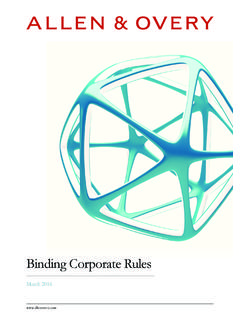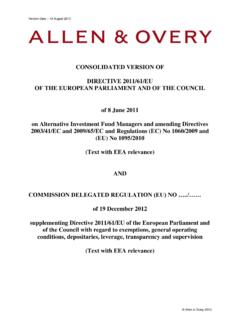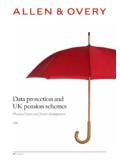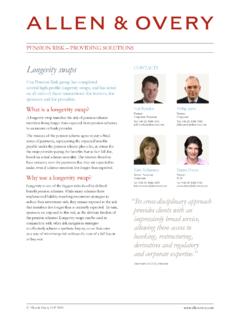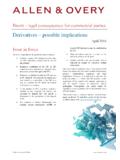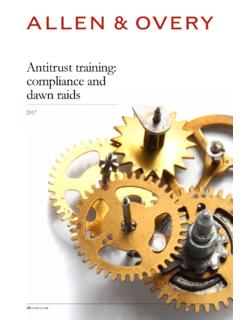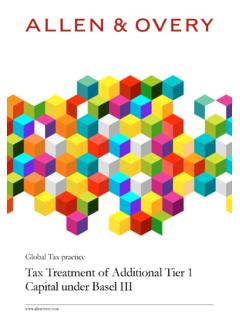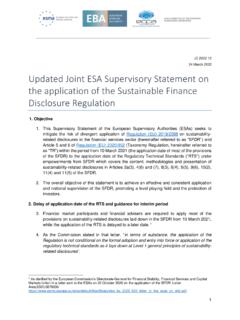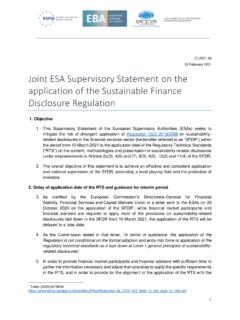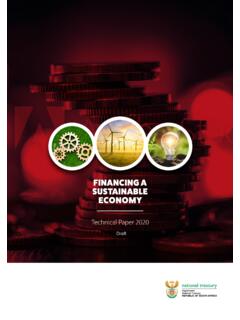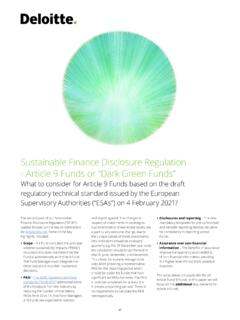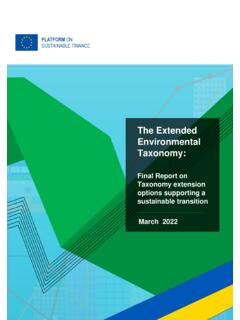Transcription of New SFDR principal adverse impacts or PAI regime – key points
1 New SFDR principal adverse impacts or PAI regime key points1. Speed readThe most innovative and challenging aspect of the EU s sustainable finance Disclosure Regulation (SFDR) is probably the new principal adverse impacts or PAI regime . This is being introduced in stages, starting from 10 March 2021. But when in full effect, it will require relevant firms to provide extensive disclosures on various ESG related matters, including greenhouse gas emissions and other indicators, in a (controversial) template format. This briefing gives further detail on the new regime and when its various strands will come into How did we get here?The sustainable finance Disclosure Regulation 2019/2088 was adopted on 27 November 2019,1 and began to apply on 10 March 2021. A final report on draft regulatory technical standards was published by the European Supervisory Authorities (ESAs) on 4 February 2021 (the RTS)2 this is now being considered by the European Commission.
2 These were initially expected to come into effect on 1 January 2022, but this has been revised as the meantime, on 15 March 2021, the ESAs published for consultation a new draft RTS for SFDR and the Taxonomy Regulation, including a consolidated version of the A truncated consultation period of 8 weeks rather than 3 months applied for this, ending on 12 May 2021. The ESAs proposed to consider the consultation responses and issue a final report which is expected shortly. This tight timetable suggests little or no changes will be made to the document being consulted on. However, this March RTS is not directly relevant to the PAI regime . For more information on how the Taxonomy Regulation interacts with SFDR, see a letter4 dated 8 July 2021, the Director-General for Financial Stability, Financial Services and Capital Markets Union of the European Commission indicated a delay to the start date of the RTS of 6 months.
3 That is, rather than beginning to apply on 1 January 2022, the RTS is proposed to now begin to apply from 1 July 2022. It is not yet clear if this will mean a delay of 6 months to all the other dates relevant to SFDR (as amended by the Taxonomy Regulation); so far, we are assuming that only the start date is affected. But this is to be confirmed and the industry may of course prefer that all relevant dates are pushed For a copy see , or for a consolidated version, see TXT/?uri=CELEX% For a copy see 03_ For a copy see joint-consultation-taxonomy-related-sust ainability-disclosures04_ For a copy see Who does the PAI regime apply to? Financial market participants (FMPs) defined in Article 2(1) SFDR as including: credit institutions (as defined in EU CRR) and investment firms (as defined in EU MiFID) providing MiFID portfolio management; manufacturers of certain types of pension products (based on definitions in EU PRIIPs); AIFMs; UCITS management companies; and insurance undertakings (as defined in EU Solvency II) that make available insurance-based investment products (IBIPs) fund link insurance products.
4 Financial advisers defined in Article 2(11) of SFDR as including: credit institutions, investment firms, AIFMs and UCITS management companies that provide investment advice as defined in EU MiFID, and insurance undertakings and insurance intermediaries that provide advice (as defined by the EU IDD) with regards to other firms voluntarily or contractually agree to comply?Yes, and we expect this will begin to occur more and more, given the amendments proposed to be made to MiFID II for ESG (as explained below). Further advice should be sought if this is contemplated, to ensure the firm is aware of the risks and issues, and can also consider how best this might be done. a firm may be prepared to commit to track what is required to be done under SFDR, or just under the PAI regime .
5 Alternatively, it may prefer to limit itself to a commercially reasonable endeavours type obligation and/or commit to a time limited obligation What ESG changes are proposed to MIFID II?On 2 August 2021, the European Commission s amendments to MiFID II for ESG were published in the official journal. The amendments include, among other things, a requirement that EU MiFD II portfolio managers and advisers ask their clients about their sustainability preferences , and then comply with such preferences when making decisions or providing advice. This term is proposed to be defined as follows (emphasis added): (7) sustainability preferences means a client s or potential client s choice as to whether and, if so, to what extent, one or more of the following financial instruments shall be integrated into his or her investment: (a) a financial instrument for which the client or potential client determines that a minimum proportion shall be invested in environmentally sustainable investments as defined in Article 2, point (1), of [the Taxonomy Regulation]; (b) a financial instrument for which the client or potential client determines that a minimum proportion shall be invested in sustainable investments as defined in Article 2, point (17), of [SFDR].
6 (c) a financial instrument that considers principal adverse impacts on sustainability factors where qualitative or quantitative elements demonstrating that consideration are determined by the client or potential client .Important points to note about this proposal: All three limbs apply to all MiFID II products (not just those within the scope of SFDR) they may in theory apply to a bond, derivative, structured product etc. In essence, the third limb on PAI would be available to product providers that consider [the] negative externalities of investments on the environment or society in terms of principal adverse impacts on sustainability , outside of the scope of It is expected that this will drive client/investor demand for more product providers to consider PAI outside the scope of SFDR.
7 Possibly this will involve such a product provider voluntarily complying with the SFDR PAI disclosure regime , at least to some extent to explain how and to what extent PAI is considered. The regulation making the changes enters into force on the twentieth day following publication in the Official Journal ( 22 August 2021) and applies from 2 August 2022. For a copy of our separate briefing on the MiFID II proposals, please ask your usual A&O :32021R1253&from=EN 06_See page 2 of Note that the ESG changes to MiFID II will also include other ESG related requirements on sustainability risk, ESG issues in product governance, conflicts etc. This is also part of a broader package of reforms across a number of sectors AIFMD, UCITS, insurance When does the pai regime apply?
8 The PAI regime is coming into force in stages, beginning on day 1 of SFDR 10 March 2021. This is explained in the timeline in Schedule 1. Market Participants (FMPs)Financial AdvisersThe new PAI regime contemplates two types of disclosures for FMPs: entity level disclosures (Article 4 SFDR); and product level disclosures (Article 7 SFDR).This is subject to an opt out for smaller firms, as discussed below. Initially, larger firms were also able to use the opt out, but this option fell away on 30 June the RTS begins to apply (now expected to be 1 July 2022), the entity level disclosure at minimum will have to follow the template in Annex I to the new PAI regime contemplates one type of disclosure for Financial Advisers: entity level disclosures (Article 4 SFDR).
9 This is subject to an opt out . NB: The opt out is available for all firms (large or small), and applies template in Annex I of the RTS does not What does the PAI regime require?7. What is the goal of the regime ?Central to the regime is the concept of sustainability factors , meaning environmental, social and employee matters, respect for human rights, anti corruption and anti bribery matters (Article 2(24) of SFDR). In general terms, firms must disclose whether or not they consider such factors ( before making investment decisions or when giving advice), and after an investment is made, whether they monitor and mitigate relevant impacts . In short, to disclose whether they consider the negative externalities of investments on the environment or , the European Commission s hope is that clients and investors will use such disclosures to select the firms they wish to buy products or services from, steering towards firms that do more on sustainability factors and away from firms that do less.
10 It is also hoped that this will have a trickle down effect; providing a strong commercial incentive for underlying investee companies and product providers to adopt the sorts of norms the Commission wishes to see become widespread on climate change, diversity, anti-bribery Summary of new PAI regime for financial market participantsHow must an FMP make the new required PAI disclosures ? Entity level disclosures These must be uploaded to the FMP s website, although (from 1 July 2022) this must be done in line with the detailed requirements in the RTS (Articles 2 and 4 RTS) : ..financial market participants shall publish the information referred to in .. Article 4 of [SFDR] and this Section on their websites in a separate section titled, principal adverse sustainability impacts statement located in the same part of the website as the section referred to in Article 31 [of the SFDR RTS re sustainability-related product disclosures ].
